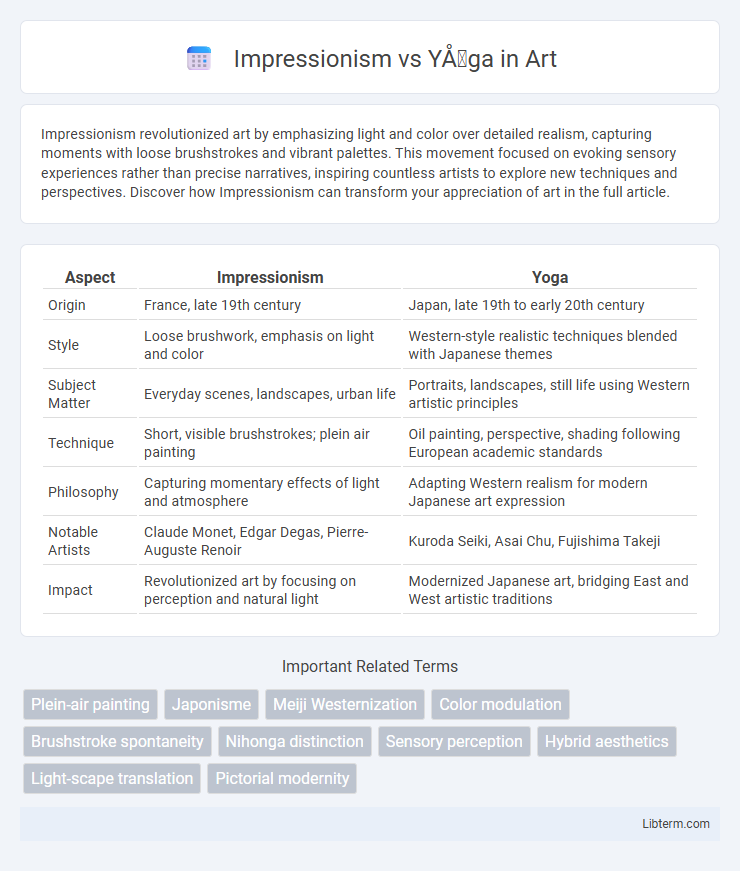Impressionism revolutionized art by emphasizing light and color over detailed realism, capturing moments with loose brushstrokes and vibrant palettes. This movement focused on evoking sensory experiences rather than precise narratives, inspiring countless artists to explore new techniques and perspectives. Discover how Impressionism can transform your appreciation of art in the full article.
Table of Comparison
| Aspect | Impressionism | Yoga |
|---|---|---|
| Origin | France, late 19th century | Japan, late 19th to early 20th century |
| Style | Loose brushwork, emphasis on light and color | Western-style realistic techniques blended with Japanese themes |
| Subject Matter | Everyday scenes, landscapes, urban life | Portraits, landscapes, still life using Western artistic principles |
| Technique | Short, visible brushstrokes; plein air painting | Oil painting, perspective, shading following European academic standards |
| Philosophy | Capturing momentary effects of light and atmosphere | Adapting Western realism for modern Japanese art expression |
| Notable Artists | Claude Monet, Edgar Degas, Pierre-Auguste Renoir | Kuroda Seiki, Asai Chu, Fujishima Takeji |
| Impact | Revolutionized art by focusing on perception and natural light | Modernized Japanese art, bridging East and West artistic traditions |
Introduction to Impressionism and Yōga
Impressionism, emerging in late 19th-century France, revolutionized Western art by emphasizing light, color, and brushstroke techniques to capture fleeting moments and sensory impressions. Yoga, the Western-style painting movement in Japan during the Meiji period, integrated European artistic methods and perspectives, blending traditional Japanese themes with realistic representation and oil painting techniques. Both movements highlight the cross-cultural exchange in art, with Impressionism influencing Yoga's adoption of realism and modern aesthetics in Japanese art history.
Historical Origins and Development
Impressionism originated in 19th-century France, characterized by artists like Claude Monet who captured light and natural scenes with loose brushwork and vibrant colors. Yoga developed in Japan during the Meiji period as Japanese artists integrated Western techniques and perspectives with traditional motifs, responding to rapid modernization and cultural exchange. Both movements emerged from distinct cultural contexts but shared an emphasis on innovation and a break from classical art conventions.
Key Artists and Influencers
Impressionism, pioneered by artists like Claude Monet, Edgar Degas, and Pierre-Auguste Renoir, emphasized capturing light and natural scenes with loose brushwork and vibrant colors. Yoga, a Japanese Western-style painting movement, was influenced by artists such as Kuroda Seiki and Asai Chu, who integrated European techniques and perspectives into traditional Japanese art. Both movements significantly shaped modern art by merging cultural aesthetics and advancing new artistic expressions.
Core Philosophies and Aesthetics
Impressionism emphasizes capturing fleeting moments with loose brushwork and vibrant light effects, prioritizing sensory experiences and the perception of color and atmosphere. Yoga, a Western-style Japanese painting movement, integrates realism, precise detail, and structured compositions, reflecting a commitment to technical skill and cultural synthesis. Both movements redefine traditional art by balancing innovation and adherence to distinct philosophical and aesthetic principles rooted in their respective cultural contexts.
Techniques and Mediums Used
Impressionism employed loose brushwork and vibrant colors to capture fleeting effects of light and atmosphere, commonly using oil paints on canvas to emphasize spontaneity and movement. In contrast, Yoga combined traditional Western oil painting techniques with Japanese subjects, emphasizing realism and perspective while integrating elements such as layering and glazing to create depth and texture. Both styles utilized oil as a primary medium but diverged in brushstroke approach and thematic focus, reflecting their distinct cultural and artistic priorities.
Major Themes and Subject Matter
Impressionism emphasizes capturing fleeting light effects, everyday urban scenes, and landscapes with loose brushstrokes and vibrant colors, highlighting movement and atmospheric conditions. Yoga, influenced by Western techniques, often incorporates realistic portraiture, historical subjects, and naturalistic landscapes, blending Japanese sensibilities with European oil painting methods. While Impressionism favors spontaneity and visual perception, Yoga balances traditional Japanese aesthetics with disciplined structure and detailed representation.
East Meets West: Cross-Cultural Influence
Impressionism, originating in late 19th-century France, influenced the Yoga movement in Japan by introducing techniques such as light brushwork and open composition, which Japanese artists adapted to Western-style oil painting. Yoga artists blended traditional Japanese aesthetics with Impressionist color theory and perspective, fostering a rich cross-cultural dialogue between East and West. This fusion contributed to the modernization of Japanese art, reflecting global artistic trends while preserving local identity.
Reception and Impact in Art History
Impressionism revolutionized Western art with its emphasis on light, color, and everyday scenes, profoundly influencing modern art movements and altering traditional academic standards. Yoga, the Western-style painting movement in Japan, integrated European techniques like oil painting and perspective, catalyzing a cultural shift during the Meiji period by merging Japanese themes with Western methods. Both movements reshaped their respective art histories by challenging conventions and broadening artistic expression across cultural boundaries.
Lasting Legacy and Modern Relevance
Impressionism revolutionized Western art with its emphasis on light and color, influencing countless modern movements and maintaining a strong presence in contemporary galleries and art education worldwide. Yoga, the Japanese Western-style painting movement, fused traditional Japanese aesthetics with European techniques, shaping Japan's modern art scene and continuing to inspire artists who seek a cross-cultural synthesis. Both movements' lasting legacy endures through their impact on global art history and ongoing relevance in discussions of cultural exchange and innovation in visual art.
Conclusion: Comparing Impressionism and Yōga
Impressionism emphasizes light, color, and natural scenes through loose brushwork and spontaneous expression, reflecting Western modernist art trends of the late 19th century. Yoga integrates Western painting techniques such as realism, perspective, and oil mediums into Japanese art, bridging traditional aesthetics with global influences during the Meiji period. Both movements revolutionized their respective art cultures by blending innovation with cultural identity, yet Impressionism remains more focused on visual perception while Yoga highlights technical adaptation and cross-cultural synthesis.
Impressionism Infographic

 libterm.com
libterm.com